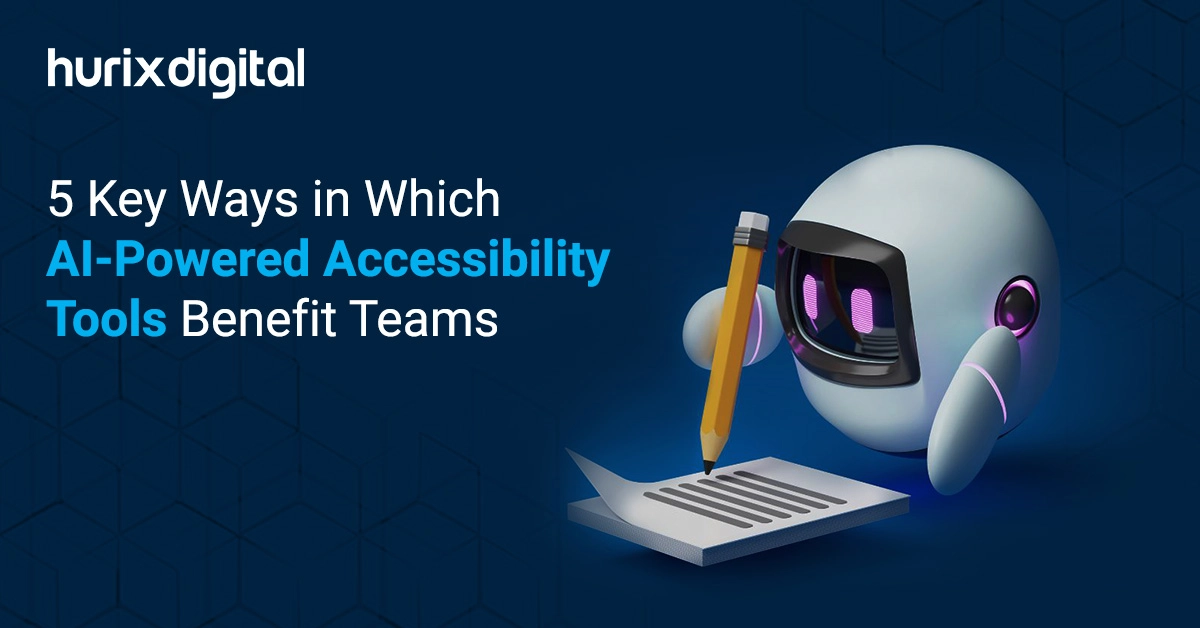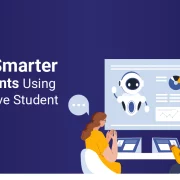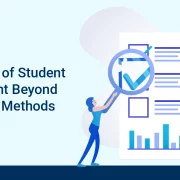
5 Key Ways in Which AI-Powered Accessibility Tools Benefit Teams
Summary
This blog discusses AI tools enhancing workplace inclusivity for employees with disabilities through AI search, speech recognition, and virtual assistants.
The introduction of AI-powered technologies in the workplace completely changes the dynamics of how an organization functions. For example, the approval process that would traditionally convey a document from desk to desk can now be automated based on company protocol and verification requirements.
In the same way, AI-powered accessibility tools have the potential to revolutionize workplace inclusivity and foster a positive work environment for everyone. Perhaps this is the reason behind a sharp rise in the market value of digital accessibility software, expected to grow to a value of $880.6 million by 2030.
Automation in accessibility promises to deliver levelized participation opportunities to all the participants of a workplace, regardless of their inherent capabilities.
Let’s explore the benefits that AI-powered accessibility tools bring to the office and how they enhance workplace inclusivity.
Table of Contents:
- AI-Powered Accessibility Tools: What are They?
- 5 Benefits of AI-Powered Accessibility for Teams
- Implement AI Accessibility Tools Effortlessly
AI-Powered Accessibility Tools: What are They?
Accessibility technology spans over a wide range of solutions that all aim to make the workplace more inclusive and accessible to people with varied needs. As such, there exist multiple types of AI-powered inclusive technologies that elevate the workplace experience for everyone.
Some of the most widely used AI-powered accessibility tools in the workplace are:
- Speech Recognition Software: For people with mobility impairments, speech recognition helps with computer control, accessing digital content, entering text, reading, and more. It helps team members communicate easily and safely.
- Cognitive Accessibility Solutions: These tools help people with special abilities access information and services housed on company portals. They are particularly helpful for enhancing accessibility in workplaces that encourage the employment of specially-abled people.
- Text-to-Speech Applications: These tools are a boon for people with visual impairment or reading difficulties who want to access and understand digital content. They help them “read” webpages, screen text, or other documents on a screen.
- Language Captions and Translations: A workplace may comprise of people from across the world who are comfortable using different languages. Using translation tools helps them access company content better.
- Image Recognition: This technology is a gift for people with visual impairments. It enables them to understand visual content by way of AI-generated descriptions that help them visualize a picture.
- Lip Reading: Lip reading technology is helpful for aurally challenged people. It generates text based on the speaker’s lip movements, helping them understand spoken content.
- User Navigation: User navigation technologies are an excellent way to help mobility-impaired employees use digital technologies or other appliances around the workplace. They work on speech recognition, gesture control, and other mechanisms to help mobility-impaired people (like seniors) access workplace services easily.
Also Read: Top 6 Reasons Why Your B2B Organization Should Care About Digital Accessibility
5 Benefits of AI-Powered Accessibility for Teams
AI-backed accessibility solutions collect a steady stream of data from their users. This data can be used to polish the accessibility systems implemented at the office and enhance workplace inclusivity for employees.
As accountability for digital accessibility grows, more organizations must ensure equitable access for all their employees.
Let’s take a look at five key ways in which AI-powered accessibility tools benefit teams at the workplace:
1. AI-Powered Search
One key accessibility advantage that AI tools bring to a workplace is AI-powered search. Company databases are often accessible to employees over the intranet. However, it is a whole new task to search for the desired resources quickly through a large repository.
In such situations, AI-powered search can help people with cognitive challenges to access the right resources in the repository without much hassle for keyword inputs. The AI engines are programmed to quickly process user requirements using NLP and other technologies and return the right results in the first few tries.
2. Speech-Directed Tasking
Organizations leverage speech-based commands to help their employees shorten their tasking time. This technology can enhance workplace accessibility for people who face challenges while typing or using gadgets. Speech-directed tasking can help them accomplish tasks without having to fidget with keys or controls.
It is also helpful for visually impaired individuals who work with images or digital content. They can use speech-based prompts to initiate processes on systems or help understand the content on the screen.
While this is similar to working with virtual assistants, AI algorithms used in speech-based tasking are more advanced and finetuned with company workflows and processes.
3. AI-Backed Training
Learning and development are inherent parts of any organization. However, for all individuals to learn and grow equitably, learning, development, and training need to be accessible to people with all kinds of capabilities.
AI-powered training provides individuals with special needs with the tools they need to keep pace with their peers easily. This includes technologies like adaptive learning, personalized learning recommendations, assisted learning, and reviews.
The availability of learning tools that help employees personalize their Training Programs is a big leap toward making them more engaging, accessible, and inclusive for people from all walks of life.
4. Virtual Assistants
Virtual assistants are accessibility tools oriented towards a more personal tasking purpose. These tools enhance accessibility in the workplace by providing employees with an adaptive interface that learns and evolves with each interaction. AI virtual assistants are programmed to evolve according to each user’s habits and usage patterns, delivering personalized interactions that are fine-tuned to the user’s behavior.
This includes understanding the busiest times, the usual searches and patterns, creating easy shortcuts based on usage, etc. These tools make it easier for employees to accomplish simple, everyday desk tasks at work with high speed and efficiency, regardless of whether they can type fast or slow or their computer skills.
5. Task Management
Accessibility is an important aspect of task management and employee efficiency. Higher task management efficiencies enhance workplace productivity and performance. However, people with impairments or challenges (mobility, visual, speech, etc.) may struggle to achieve everyday, simple tasks like setting reminders or scheduling a meeting.
AI-powered productivity apps make such features more accessible to people with special needs. They assist with automated meeting scheduling, auto-reminders, notifications, etc., to help them navigate the workplace with as much ease as any other employee.
Read EXCLUSIVE Success Story: Hurix Digital Enhances Accessibility for Over 100,000 Students for a US-Based Community College
Implement AI Accessibility Tools Effortlessly
Artificial intelligence has provided the world with countless solutions and tools that enhance the ease of doing work. It has especially unlocked a realm of equitable productivity and access for especially or differently-abled people in the workplace.
Through the implementation of tools like speech recognition, text-to-speech, AI-powered productivity, etc., employees can tailor their working methods for optimized outputs.
For organizations looking to implement workplace inclusivity using AI-powered accessibility tools, Hurix Digital has the right technology and expertise to provide seamless services.
Hurix Digital is your reliable technology and service partner for workplace AI for accessibility, including accessibility audits, video-based accessibility, Alt-text writing, 508 compliance testing, and more.
To implement AI in workplace efficiency, contact us today.

Vice President – Digital Content Transformation. He is PMP, CSM, and CPACC certified and has 20+ years of experience in Project Management, Delivery Management, and managing the Offshore Development Centre (ODC).



